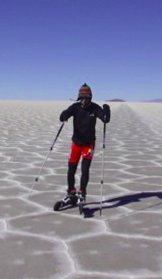Cross skate
Cross skates are a variant of inline skates that are suitable for use in light to medium-difficult terrain. They consist of a sturdy frame to which two or more pneumatic tires are attached. The shoe is either integrated or can be attached to the frame with buckles or an optional folding rail. Most cross skates have at least one brake per pair of cross skates. In contrast to inline skating, the propulsion in cross skating is mainly generated with the help of sticks. The driving behavior of cross skates also differs considerably from that of inline skates.
technology
Over 40 models were and are available on the market, some of which differ significantly in their structure. Almost all of them are based on an inline construction, in which two or more rollers are attached one behind the other.
frame
The frame of a cross skate, which is usually made of aluminum and carries the driver, is connected to two or more wheels. Depending on the version, the wheels are either - similar to conventional inline skates - below the frame or - much more often - at its front and rear ends. Many models allow changing the position of the bike, shoes and brakes on the frame. Two-wheeled models with wheels at the front and rear of the frame share some similarities with roller skis .
Shoes
Depending on the model, the shoes are already integrated in Crossskates or they can be fixed to a shoe holder provided on the frame with the help of buckles. Models with shoe holders and buckles allow easy buckling and buckling and a flexible change of shoes. A calf support provides additional stability in these models.
roll
Cross skates are equipped with ball-bearing wheels with pneumatic tires as standard . The wheels are significantly larger than those of an inline skate. Their diameter is about 15 cm. The ball bearings are more robust than most inline skate bearings and must also be more resistant to dirty water.
Brakes
Most cross skates come with brakes as standard. Different braking systems, one or two-sided, depending on the design, are used. The two-sided fallback brake introduced by Skike , which is operated with the calves and allows decelerations of up to 6.5 m / s 2 , is of greatest importance . Other manufacturers are also increasingly using this braking system.
Folding rail
Some manufacturers, such as Powerslide and Skike , offer cross skates with folding rails . In these models, the shoe or the shoe holder is not attached directly to the frame, but rather on a folding rail connected to the frame. The use of a folding rail is primarily intended to further adapt the movement technique of the cross-country skiing technique and, in combination with a backstop, enable movement in the classic cross-country skiing style .
Additional equipment
Cross skates are usually used together with sticks to support the propulsion. These are significantly longer than Nordic walking sticks and mostly have carbide tips for use on asphalt and off-road. Helmet, knee pads and special Nordic skating gloves are usually worn as protective equipment. To protect the eyes from the tips of other drivers' sticks , sports glasses are practically always worn during group rides and competitions .
Drive
Due to the higher dead weight, the size and above all the directional stability, the possibilities of movement with cross skates differ considerably from those with inline skates. Steering and cornering are only possible to a limited extent without changing, especially with the two-roller systems. When using the skating technique, propulsion takes place by means of a lateral impression. An additional print to the rear that is possible when inline skating is not possible with the true-to-track cross skates. Poles are used to supplement the advance. This type of movement is also known as Nordic (cross) skating . The slide braking techniques known from inline skating are also not possible with two-roller cross skates. For this purpose, cross-skates can be equipped with powerful braking systems that enable controlled full braking while maintaining the direction of travel.
The skating techniques known from cross-country skiing are possible with the use of Nordic blading sticks . These include the 2: 1 guide arm technique, the 2: 1 technique with active arm swing, the 1: 1 technique and diagonal skating. In addition, the permanent push technique specially developed for cross skating is considered a very effective method of locomotion. While the double-decker push is possible on all cross-skates, models with folding rails and optional backstops enable double-decker pushing with an intermediate step and movement using the classic diagonal step technique.
use
Cross skates are mainly used in recreational and popular sports . Some competitive athletes also use cross skates for endurance training . Competitions with cross skates, such as Nordic skating or modern biathlon, are still quite rare.
Web links
- http://www.cross-skating.de - German cross skating magazine
- http://www.cross-skating-forum.de - Specialist forum for cross-skating sport
- https://cross-skating.aktiv-forum.com - Specialist forum for cross-skating sport

